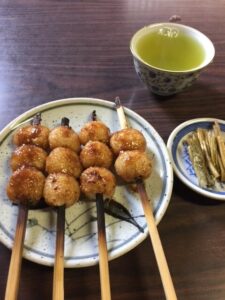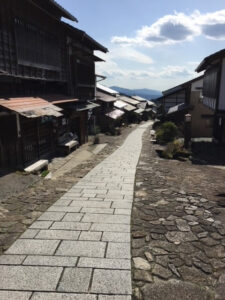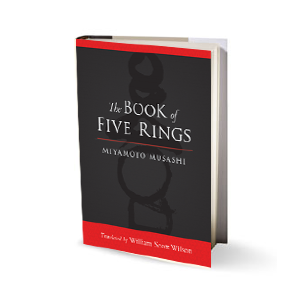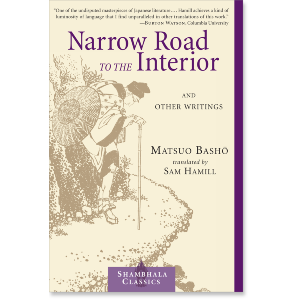In early April of this year I made a solo trip from Brooklyn, NY, where I live, to Japan. It was my first trip to the East, and one I had contemplated for years before actually making the plunge. I work in publishing and my employer, Penguin Random House, distributes books from Shambhala Publications. One of my favorite books on Japan is William Scott Wilson’s Walking the Kiso Road, published in 2015. I remember when the book was first presented to our sales team–being the Japanophile that I am–I thought, “If I ever go to Japan, I’m going to walk that road.”

The Kiso Road is an old route taken by Japanese farmers, loggers, warlords, and assorted pilgrims for at least two thousand years; it’s part of a longer road (the Nakasendo) that connects Kyoto, the original capital of Japan, with Tokyo. It is a mountainous region and the Kiso river runs through deep gorges and dense cypress and pine trees. Along the road are juku, or post towns, which sprang up as a result of the road being there. In the post towns pilgrims could find food and lodging, a respite from their long journey. William Scott Wilson, the translator of best sellers including Hagakure and The Book Five of Rings, spent several weeks along the Kiso Road, staying in a different post town each night and recording his encounters with the local villagers and his reflections on the culture, food, and philosophy of Japan. The book is sprinkled with wonderful ancient Japanese quotes and haiku; each chapter focuses on a different post town along the road.
When I began to plan my Japan adventure, I decided to spend two days in Tokyo, three days in Kyoto (where my focus would be on the many Buddhist temples and shrines), and my final two days hiking the Kiso road, staying in a couple of the juku along the way. One of my favorite quotes from the book is from the Japanese poet Basho: “You should not sleep twice in the same inn. Your thoughts should be on a mat that has not yet been warmed.” Inspired by this, I planned to stay in a different hotel or inn each night that I was in Japan.
The planning of the trip was filled with some natural trepidation: what if I got lost and could not find an English speaker to assist me? Fortunately I was introduced to an American author intimately familiar with travel in Japan, Susan Spann, who it turned out had hiked the Kiso road. So, with William Scott Wilson’s book and Susan’s many travel tips, I boarded my plane at JFK airport ready for whatever fate had in store for me.
Walking the Kiso Road is divided into two main sections, “The Upper Kiso” and “The Lower Kiso,” as the elevation along the road increases if you begin from one end. Wilson started his journey in the upper valley and ended in the lower. I began mine in the lower Kiso, in a town called Magome. I took two trains and a bus from Kyoto to Magome. Arriving in the afternoon, I spent my first night at an old guest house, Magomechaya, in a room with a view of Mount Ena, the tallest mountain in the region.
Japanese guest houses and inns are much like bed and breakfasts and typically serve a communal evening meal, providing you with the opportunity to meet fellow travelers and experience some of the very best food anywhere in Japan. Most of the hikers I met were Westerners, but from either Europe or Canada. My first morning in Lower Kiso I awakened at dawn, gathered my belongings into my backpack, and started out before breakfast. I had snack food and wanted to make it to a few towns along the way before getting to my final destination, a town in the Upper Kiso called Narai (which ultimately required a short train ride).
The road is well marked with signs in Japanese and English. I hiked alone for much of the day, encountering only a few hikers, going the opposite way. Signs warning of bears were posted, along with a bell, which you could ring to scare the bear away. I did not, however, see any bears.

Hiking the Kiso Road is like going back in time. The post towns have changed little over hundreds of years; you don’t see electrical wires, although the two guest houses where I stayed, Magome and Narai, had power and internet access. The guest house in Narai was one that William Scott Wilson himself described in the book. There are shops that cater to travelers with locally made crafts, wood carvings, and jewelry. The locals speak some English, but I discovered that initiating a conversation in Japanese was the best way to get assistance. One of the tasty lunch treats I had was gohei mochi, fried rice balls dipped in a sweet sauce. I can still taste them.

On my way to the train station in Nojiri, one of the post towns in the Lower Kiso, I found myself coming down the steep Kiso Road and passing a grassy field where a group of Japanese were having a picnic. It was a beautiful Spring day, and this elderly woman waved when she saw me. At first I thought she must be mistaking me for another Westerner, but I was the only one on the road, and she ultimately approached me and offered me a bowl of miso soup. In Japanese, she asked if I wanted to join them. At first I begged off in my broken Japanese, but she insisted that I eat with them, so I did. It was a delightful way to end that part of my journey and a moment that perfectly encapsulated the Japanese experience for me.
Having only spent one week in Japan and two days in the Nakasendo, I have already started thinking about a second, more extensive hike when I revisit Japan in the next year or two. I owe a debt of gratitude to William Scott Wilson for the inspiration and the subtle wisdom that his book continues to impart every time I pick it up.

Related Books
$21.95 - Paperback
$12.95 - Paperback
$19.95 - Hardcover
$19.95 - Paperback
$22.95 - Paperback







